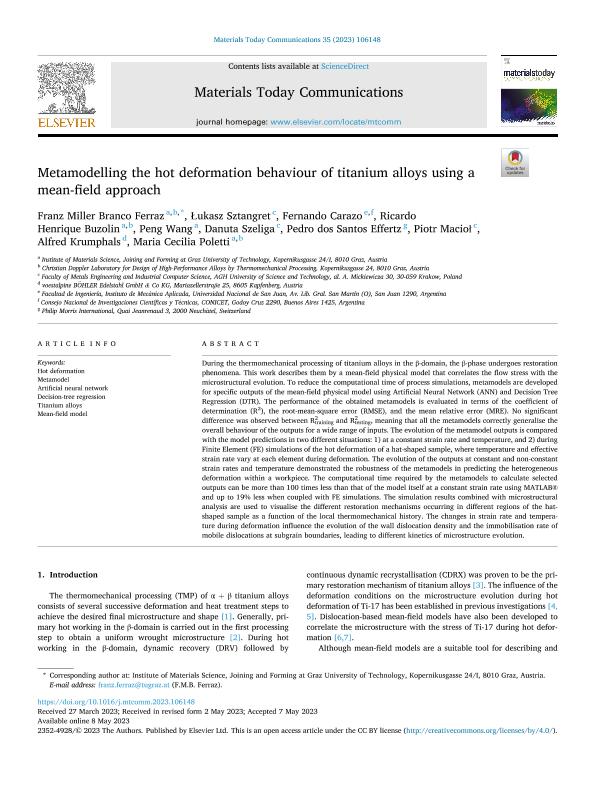Artículo
Metamodelling the hot deformation behaviour of titanium alloys using a mean-field approach
Miller Branco Ferraz, Franz; Sztangret, Lukasz; Carazo, Fernando Diego ; Buzolin, Ricardo Henrique; Wang, Peng; Szeliga, Danuta; dos Santos Effertz, Pedro; Macio, Piotr; Krumphals, Alfred; Poletti, Maria Cecilia
; Buzolin, Ricardo Henrique; Wang, Peng; Szeliga, Danuta; dos Santos Effertz, Pedro; Macio, Piotr; Krumphals, Alfred; Poletti, Maria Cecilia
 ; Buzolin, Ricardo Henrique; Wang, Peng; Szeliga, Danuta; dos Santos Effertz, Pedro; Macio, Piotr; Krumphals, Alfred; Poletti, Maria Cecilia
; Buzolin, Ricardo Henrique; Wang, Peng; Szeliga, Danuta; dos Santos Effertz, Pedro; Macio, Piotr; Krumphals, Alfred; Poletti, Maria Cecilia
Fecha de publicación:
06/2023
Editorial:
Elsevier
Revista:
Materials Today Communications
ISSN:
2352-4928
Idioma:
Inglés
Tipo de recurso:
Artículo publicado
Clasificación temática:
Resumen
During the thermomechanical processing of titanium alloys in the β-domain, the β-phase undergoes restoration phenomena. This work describes them by a mean-field physical model that correlates the flow stress with the microstructural evolution. To reduce the computational time of process simulations, metamodels are developed for specific outputs of the mean-field physical model using Artificial Neural Network (ANN) and Decision Tree Regression (DTR). The performance of the obtained metamodels is evaluated in terms of the coefficient of determination (R²), the root-mean-square error (RMSE), and the mean relative error (MRE). No significant difference was observed between R2training and R2testing, meaning that all the metamodels correctly generalise the overall behaviour of the outputs for a wide range of inputs. The evolution of the metamodel outputs is compared with the model predictions in two different situations: 1) at a constant strain rate and temperature, and 2) during Finite Element (FE) simulations of the hot deformation of a hat-shaped sample, where temperature and effective strain rate vary at each element during deformation. The evolution of the outputs at constant and non-constant strain rates and temperature demonstrated the robustness of the metamodels in predicting the heterogeneous deformation within a workpiece. The computational time required by the metamodels to calculate selected outputs can be more than 100 times less than that of the model itself at a constant strain rate using MATLAB® and up to 19% less when coupled with FE simulations. The simulation results combined with microstructural analysis are used to visualise the different restoration mechanisms occurring in different regions of the hat-shaped sample as a function of the local thermomechanical history. The changes in strain rate and temperature during deformation influence the evolution of the wall dislocation density and the immobilisation rate of mobile dislocations at subgrain boundaries, leading to different kinetics of microstructure evolution.
Archivos asociados
Licencia
Identificadores
Colecciones
Articulos(CCT - SAN JUAN)
Articulos de CENTRO CIENTIFICO TECNOLOGICO CONICET - SAN JUAN
Articulos de CENTRO CIENTIFICO TECNOLOGICO CONICET - SAN JUAN
Citación
Miller Branco Ferraz, Franz; Sztangret, Lukasz; Carazo, Fernando Diego; Buzolin, Ricardo Henrique; Wang, Peng; et al.; Metamodelling the hot deformation behaviour of titanium alloys using a mean-field approach; Elsevier; Materials Today Communications; 35; 6-2023; 1-16
Compartir
Altmétricas



